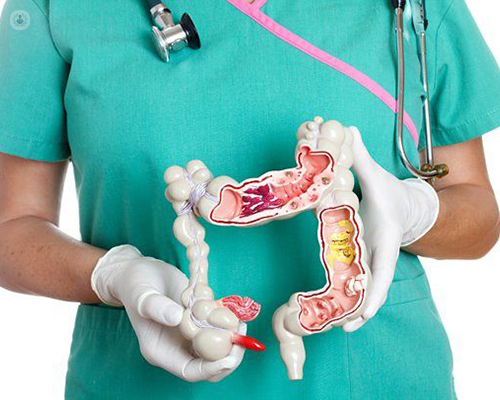Minimally-invasive techniques in gastroenterology
Escrito por:Minimally invasive techniques can be used to diagnose most gastrointestinal conditions, such as ulcerative colitis or diverticular disease. Gastroenterologist Professor Owen Epstein specialises in minimally invasive procedures and here he explains the different tools used to make a diagnosis, how they work and what the future holds for technologies in gastroenterology.

What techniques do you use and how do they work?
The following techniques are used to diagnose gastrointestinal conditions:
- Capsule endoscopy (PillCam)
Capsule endoscopy is a new device in gastroenterology. The capsule is swallowed with water, propelled by the natural movement of the digestive tract and wirelessly transmits a video of the inner lining of the bowel from mouth to rectum. Because the majority of patients undergoing upper and lower fibre-optic endoscopy do not have serious damage to the lining, the less invasive capsule endoscopy can scout out the landscape and only if necessary, calls on traditional fibre-optic endoscopy to biopsy or remove a significant polyp. The capsule has good accuracy and asks the question "who needs an endoscopy?".
- Virtual CT colonoscopy
Virtual colonoscopy uses CT scanning to provide images of the large intestine. A small flexible rubber tube is passed through the anus into the rectum and the large intestine is inflated with carbon dioxide. Prior to the procedure, patients drink a contrast agent allowing a computer program to "subtract" any residual bowel debris and excellent images of the gas-distended bowel are obtained. The procedure has the same accuracy as fibre-optic colonoscopy for polyps and diverticulosis but is unable to accurately diagnose colitis (inflammation) or bleeding blood vessels (angiodysplasia).
- Echogastrography
This is an ultrasound test. The patient drinks a cup of tomato soup and the radiologist can then observe stomach contractions as they occur in real time. The test is used to assess the pumping mechanism of the stomach and is very useful when investigating patients with indigestion (nausea and/or upper abdominal discomfort), in who there is no evidence of damage to the lining on fibre-optic or capsule endoscopy of the stomach.
How readily available are these diagnostic techniques?
Most hospitals can offer virtual colonoscopy but fewer have expertise in whole bowel capsule endoscopy and echogastrography.
What advancements could be made in minimally-invasive technologies for gastroenterology?
In the next decade, capsules will be developed that use light-physics or sonar to provide "biopsy" information. There is also an early prototype capsule that can be delivered without the need to clear the bowel with laxatives.
What does the future look like for minimally-invasive gastroenterology?
Miniaturisation and chip technology will continue to advance the evolution of gastrointestinal diagnostic devices, providing patients with much less invasive options that can be safely and painlessly delivered in primary care or even in the home.
Do not hesitate to book an appointment with a specialist about your options in diagnosing a gastrointestinal problem.


